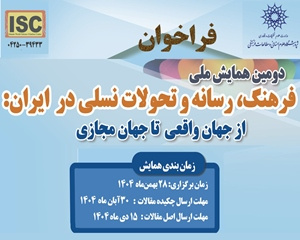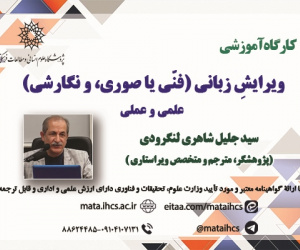تحلیل ظرفیت های قصه های عرفانی به مثابه راهبردی در آفرینش درام ایرانی (با بهره گیری از مطالعات قاسم هاشمی نژاد) (مقاله علمی وزارت علوم)
درجه علمی: نشریه علمی (وزارت علوم)
آرشیو
چکیده
مروری بر آثار تولیدی در عرصه ی درام ایرانی، نشان از تلاشی مستمر در پرداخت روایت های نو دارد اما آنچه مشهود است اینکه محصول این تجربیات چون در پی یافتن مصادیق در جایی بیرون از جغرافیای فرهنگی-ادبی ایران بوده اند؛ و مهم تر از آن، سعی در گزینش چارچوب نظری اصطلاحاً غیربومی و سوارکردن آن بر داستان سرایی ایرانی داشته اند، نسبت تامی با اهداف خود ندارند. بر مبنای این مسئله، پژوهش حاضر بنا دارد، در راستای ارائه راهبردی نو در آفرینش روایت و درام ایرانی، برخلاف آسیب های برشمرده فوق گام بردارد. لذا با اتخاذ روشی توصیفی- تحلیلی، نخست چارچوب نظری خود را برگرفته از آراء یکی از صاحب نظران بومی، قاسم هاشمی نژاد، استوار خواهد ساخت که در صورت بندی یک دستگاه تحلیلی ایرانی در مواجهه با هر دو حوزه امر داستانی و نمایشی تلاش کرده و دوم در عرصه مصادیق، فرض بنیادین خود را به «قصه های عرفانی» و ارائه تمهیدات و مصادیقی برگرفته از سنت روایت در ادبیات عرفانی معطوف خواهد داشت. یافته های تحقیق نشان می دهند که با نگاه به جوهره ادبیات فارسی، ویژگی ها و تجلیات آن می توان به عمق ظرفیت های شگرفی دست یافت که توأمان در تحلیل و مصادیق مشهود است. ماهیتی که خصیصه بودشی هنرش در برابر ویژگی نمودشی هنر غرب، پوشاندن ردای غیر ایرانی را بر آن بدقواره می سازد. کمینه های عرفانی جدای ماهیت وحدانی و هدف باطنی آن در شناخت محبوب ازلی، واجد کیفیت های بیانی، روایی و حتی نمایشی هستند که به مثابه راهکاری برای خلق روایت های نو، ظرفیت فراوانی برای پرداخت درام ایرانی داشته و می تواند دریچه ای به سوی درام ملی در این عرصه بگشاید. درامی که نسخه بدلی هیچ فرهنگ دیگری نبوده، از هویت این سرزمین بیرون آمده و ازجمله کیفیت های نمایشی آن ها تمهیدات به کاررفته در گشایش، ساختار روایت، خلق موقعیت، سیاق دیالوگ پردازی، ایجاز، الگوهای بیان مضمون، مستندسازی، باورپذیری و درنهایت وجه انفجاری پایان بندی است.Narration in mystical literature as a strategy in creating Iranian drama )based on Qasim Hasheminejad 's perspectives)
Reviewing Iranian dramas shows a constant effort to create new narratives, but clearly, the results do not completely fulfill their goals due to two major reasons: First, they provide examples which are not within our literary and cultural boundaries (which, at best, has no achievement other than repeating the same western narrative forms and is not very compatible with the taste of Iranians); And more importantly, they try to choose a so-called non-native theoretical framework and apply it to Iranian storytelling, even though the Iranian mindset is completely different from Western epistemology in analyzing and explaining an artwork. Regarding this problem, the current research intends to take a step toward presenting a new strategy for creating an Iranian narrative or drama. Adopting a descriptive-analytical method, we will first build a theoretical framework based on the opinions of one of the prominent local experts, Qasim Hasheminejad, who has made a special effort to formulate an Iranian analytical apparatus concerning both fields of fiction and drama. And secondly, regarding examples, our basic assumptions will be "mystical stories". The findings of the research show that by looking at the essence of Persian literature, its characteristics, and manifestations; it is possible to reach the depth of its tremendous capacities that are evident in the analysis and examples. An art whose inherent distinctive, compared to the characteristics of Western art, makes it unseemly and unpleasant to cover it with a non-Iranian cloak. Apart from its unitary nature and its inner purpose in knowing the eternal beloved; mysticism has expressive, narrative, and even dramatic qualities that can be used as a way of creating new narratives (based on Iranian taste), leading to create “national drama”. A native self-originated drama that is not a follower or copy of any other culture. Among the dramatic qualities in these types of stories, we can mention the course of actions used in the opening, narrative structure, state of the situation, dialogue processing, brevity, theme expression patterns, documentation, believability, and finally the explosive aspect of the ending.



